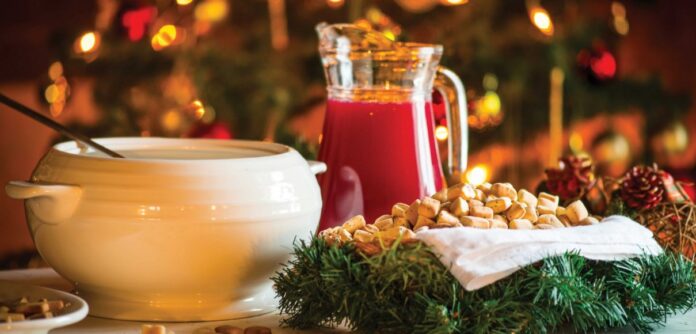
Since ancient, pre-Christian times, Kūčios has been a most unique family dinner, a ritual of celebrating the return of the sun at the winter solstice, and later – waiting for the birth of Christ. In our day and age, many traditions slip away, and the Kūčios meal is no exception. In larger families, there will inevitably some who cannot or will not eat fish, whether smoked, sauced or marinated. This can be a dilemma for the hostess, but these days cheese and mushrooms in particular can come to the rescue – stuffed, wrapped in crepes or dumplings. Potatoes are also an option. Another excuse to make “kugelis”…?
Aside from the tradition of refraining from meat (although shrimp and other seafood are not actually in the fasting category), many households no longer have the time or inclination to serve the less “modern” Kūčios dishes that are the most traditional. “No one eats it anymore”, is the reason behind abandoning poppy seed milk, “kūčiukai” – poppy seed biscuits, and even “kisielius” – cranberry pudding. And making “kūčia” (see previous article) has likely become extremely rare, especially outside of Lithuania.
Time-consuming though they may be, these distinctive dishes may be worth trying again, but in smaller quantities, if only for ritual value, interesting conversation or a teaching tool for younger generations. In Lithuania, the trend toward shortcuts, even to the point of “takeout Kūčios” is being lamented by ethnographers, according to several recent articles in the media.
In the diaspora, of course, not all products may be available for the Kūčios meal. Family traditions, stemming from different regions of Lithuania, may also change the Kūčios menu. The most important thing is to nurture the spirit of Christmas Eve, the togetherness of family and the traditional sacred meaning of the occasion. Various sources imply that in essence, the “rules” are to abstain from meat, serve fish (herring is king), and to use poppies and cranberries in some form.
The tradition of serving twelve dishes apparently evolved from an original nine, and, in olden days, referred to giving thanks for every month of the past year, with a nod to the twelve apostles coming into practice with Christianity. The Christmas wafer or “paplotėlis” used for the Kūčios greeting ritual can be counted as one of the twelve.
“Kūčiukai”, poppy seed biscuits, sometimes disappear from the menu because they are known to be hard and tasteless. Yet they are described as one of the most traditional foods from Lithuania’s deep past. Poppyseeds symbolized abundance and prosperity.
Maybe they are worth trying again? In case you dislike baking with yeast, here is a recipe from the famous Lithuanian chef Beata.
 “Kūčiukai“
“Kūčiukai“
500 grams all purpose flour (4 cups)
1 tablespoon baking powder
2 tablespoons honey
200 ml water (6¾ oz)
2–3 tablespoons sugar
80 ml vegetable oil (about 5½ tablespoons)
Dash salt
30 grams poppy seeds (about 3½ tablespoons)
Mix flour, poppy seeds, baking powder and salt in a bowl. Mix water with honey and sugar, add to dry ingredients and combine, to make a soft, elastic dough.
Roll portions of dough into ropes, slice into 1” pieces and bake at 350oF on parchment-lined cookie sheets for 9-15 minutes, until golden.
(This recipe could probably be halved.)
Traditional “Kūčiukai” with Yeast
Warning: This recipe has been halved and converted from metric.
2 cups flour
2¼ teaspoons (1 package) dry yeast
½ cup sugar
Dash salt
¼ cup poppy seeds
2-3 tablespoons oil
¾ cup milk
In a large bowl mix flour with yeast, sugar and salt.
Cover poppy seeds with boiling water in a cup, allow to soak for 5 minutes, then drain. Whisk into dry ingredients. Add oil and milk. Mix well, then knead on a flat surface until the dough is no longer sticky. Oil the bowl and put the dough back in to rise for an hour or two, covered with a dishtowel or plastic wrap. Take portions of dough and shape into ropes, slice and bake at 350oF on parchment-lined cookie sheets for 9-15 minutes, until golden.
Are you in the mood yet? Finally, just for old times’ sake – you can make a small amount of poppy seed milk in a pretty jug, just to decorate the table.
Take one cup of poppy seeds, cover with boiling water, add sugar or honey to taste and a dash of salt, allow to soak for 20 minutes. Grind the mixture in a blender, pour into a pitcher and serve cold. It counts as one of the twelve dishes!



























